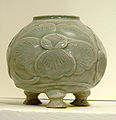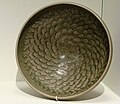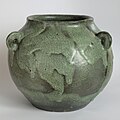Celadon
Jump to navigation
Jump to search
English: Celadon is a term for ceramics denoting both a type of glaze and a ware of a specific colour, also called celadon. This type of ware was invented in ancient China, particularly in Zhejiang Province.
Chinese celadon
[edit]-
Chinese celadon with cut-out and engraved decoration, 10th century. From the Musée Guimet, Paris.
-
Chinese celadon with cut-out and engraved decoration, 10th-11th century. From the Musée Guimet, Paris.
-
Detail of a celadon candle holder. Three Kingdoms Period (A.D. 220 - 280). Excavated at Nanjing, Jiangsu Province, 1958.
-
Celadon candle holder. Three Kingdoms Period (A.D. 220 - 280). Excavated at Nanjing, Jiangsu Province, 1958.
-
Detail of a celadon Soul Vase. Western Jin Dynasty (A.D. 265 - 326). Excavated at Shaoxing, Zhejiang Province.
-
Detail of a celadon Soul Vase. Western Jin Dynasty (A.D. 265 - 326). Excavated at Shaoxing, Zhejiang Province.
-
Detail of an embellishment on the side of a celadon Soul Vase. Western Jin Dynasty (A.D. 265 - 326). Excavated at Shaoxing, Zhejiang Province.
-
Detail of a celadon Soul Vase. Western Jin Dynasty (A.D. 265 - 326). Excavated at Shaoxing, Zhejiang Province.
-
Celadon Soul Vase. Western Jin Dynasty (A.D. 265 - 326). Excavated at Shaoxing, Zhejiang Province.
-
Celadon dish with applied dragon design. Longquan ware, Yuan Dynasty (1271-1368). On display at the Shanghai Museum in Shanghai, PRC.
-
Celadon huzi (chamber pot), Western Jin, 265-317 CE, Shanghai Museum.
-
A green-ceramic jar, from the Chinese Han Dynasty (202 BCE – 220 CE). Cernuschi Museum, Paris.
-
Chinese bowel, Northern Sung dynesty, 11th or 12th century, porcelaneous pottery with celadon glaze, Honolulu Academy of Arts.
-
Chinese Wine Vessel with a mountain-shaped lid. Han Dynasty.
-
Celadon dish from the Yuan dynasty, in the china collection of the Topkapi Palace in Istanbul.
-
Porcelain dish from Shaanxi, China. 10th-11th century. From the Musée Guimet, Paris.
-
Porcelain dish from Shaanxi, China. 10th-11th century. From the Musée Guimet, Paris.
-
Porcelain dish from Shaanxi, China. 10th-11th century. From the Musée Guimet, Paris.
-
Porcelain dish from Shaanxi, China. 11th-12th century. From the Musée Guimet, Paris.
-
Porcelain dish from Shaanxi, China. 11th-12th century. From the Musée Guimet, Paris.
-
Celadon five tube jar and cover with carved lotus petal design. Longquan ware, Song Dynasty, (960-1279). On display at the Shanghai Museum in Shanghai, PRC.
-
Vessel from Shaanxi, China. 10th century. From the Musée Guimet, Paris.
-
A Chinese Western Jin Dynasty (265-316 AD) celadon ceramic jar with human figures, animals, and architecture.
-
Celadon bo (bowl) with modeled dragon design. Longquan ware, Yuan Dynasty, reign of Daoguang (1271-1368). On display at the Shanghai Museum in Shanghai, PRC.
-
Detail of Chinese celadon shard unearthed from Southern Sung Dynasty Ruins (12th century). About 1 inch across.
-
Ming Dynasty planter. Found in Zhejiang province of China. Known as "Longquan ware". Built in the 14th or 15th century. Stoneware with celadon glaze. It is housed in the Smithsonian Institution in Washington D.C.
-
Buddhist statue in Hong Kong.
-
Song or Yuan Dynasty celadon ware.
-
A Chinese Western Jin Dynasty (265-316 AD) celadon ceramic candle holder in the shape of a kneeling sheep.
Goryeo celadon
[edit]Goryeo celadon refers to all types of Korean pottery produced during the Goryeo dynasty which were created using a celadon glaze.
-
Applying the sanggam (inlay decoration) method onto the vase.
Modern Celadon wares
[edit]-
Celadon bowl with Iron oxide. 2007.
-
Celadon vase with Iron oxide. 2007.
-
Celadon vessel by Wanda Golakowska. 2nd half of 20th century.















































